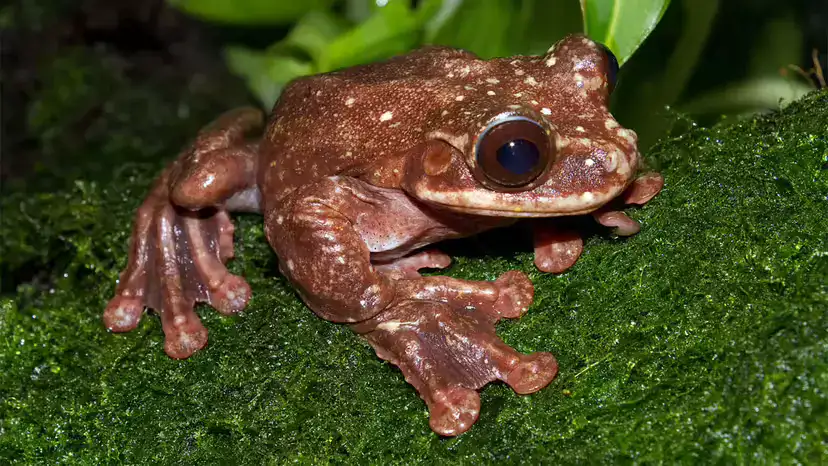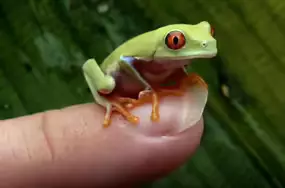Bottom line: Since ~1970 the world has lost ~200 frog species. Frogs survived the dinosaur-ending K–Pg extinction, yet today multiple stacked pressures—habitat loss and fragmentation, disease (chytrid fungi), hydrological change, climate stress, and human transport—are pushing many species toward collapse. Recovery is still possible where threats are tackled together, not piecemeal.

Amphibians often have tiny ranges and high turnover across short distances—especially in tropical mountains. Replace the forest on one ridge and you may erase an entire endemic species. Small ranges = high extinction risk from even “local” habitat change.
Most frogs migrate seasonally between aquatic sites (breeding/larval stages) and terrestrial refuges (foraging/overwintering). Drains, levees, culverts, roads, and fences that slice across wetlands block movements and shred populations. Draining or polluting a “minor” pond can wipe out the only breeding site for a valley.
Frogs rely on surface water timing (rain pulses, hydroperiod). Droughts shorten larval development windows; heatwaves and shifting rainfall desynchronize breeding and increase disease stress. Coastal species face saltwater intrusion and storm-surge loss of freshwater.
Bd (Batrachochytrium dendrobatidis) infects the keratinized skin of amphibians, disrupting electrolyte balance and cutaneous respiration, often leading to fatal cardiac failure.
Outbreaks can crash entire assemblages within a year.
Human vectors—wildlife trade, bait, labs, pet releases, gear moved between waters—accelerate spread.
Pollution alone seldom causes global extinctions, but it can weaken immune responses, making Bd impacts worse.
Frogs aren’t universally “pollution-proof”: sensitivity varies by pollutant, species, life stage, and water chemistry.
Not if we address multiple threats together. Many species persist or rebound where managers (and communities) combine habitat protection/restoration + connectivity + disease biosecurity + hydrology fixes, instead of tackling one driver in isolation.

Protect and reconnect habitat
Map breeding sites and upland refuges together; protect both.
Build wildlife underpasses/eco-culverts, retrofit road verges, and remove barrier fencing.
Restore hydrology: refill or regrade ephemeral ponds, uninstall unnecessary drains, add woody debris/vegetation for cover.
Biosecurity for disease
Clean–drain–dry footwear, waders, nets, buckets between every waterbody.
Regulate trade: captive-bred, screened animals only; no wild translocations.
Quarantine protocols for research, rescue, and reintroduction.
Refugia and climate adaptation
Create a mosaic of ponds with staggered hydroperiods (some short, some long) to spread climate risk.
Maintain riparian shade to cool water and limit pathogen growth.
Protect elevational gradients so species can shift upslope.
Community & policy
Incentivize wetland set-asides on private lands.
Support early-warning monitoring (acoustic loggers, eDNA water samples).
Fund rapid response for mass-mortality events and rescues during dredging/works.
“There’s a woodlot near me—frogs will be fine.”
Maybe not. Without fish-free breeding ponds connected to that woodlot, local frogs may eventually vanish.
“Pollution is the main killer.”
It’s a killer—locally— but the global crashes tie most strongly to habitat loss/fragmentation + Bd (and other pathogens) + climate stress acting together.
“Frogs survived the dinosaurs—today’s changes can’t be worse.”
The pace and granularity of modern change (roads, ditches, dams, pathogens moved continent-to-continent) are different. Evolution can’t always keep up.
At the water’s edge:
Disinfect boots/gear between wetlands (bleach solution or commercial virucide; then rinse and dry).
Keep dogs out of breeding ponds during spawning.
Never introduce fish/turtles to “help”—they eat tadpoles.
At home & school:
Convert a corner to a fish-free native pond with shallow shelves and leaf litter.
Plant native shrubs/groundcover as humid corridors between ponds and woods.
In the marketplace:
Avoid buying wild-caught frogs/frog legs; choose verified farmed sources where legal.
Don’t release classroom/pet amphibians—contact a rescue.
Civics:
Back wetland protections, road-crossing retrofits, and pathogen-control rules in wildlife trade.
Join or fund volunteer call-surveys and eDNA monitoring.
Are there climate-linked frog extinctions?
Direct attribution is hard, but climate already reduces survival/fecundity and shrinks hydroperiods; it compounds disease and fragmentation risks that drive extinctions.
Why do some ponds teem with frogs while others nearby are empty?
Subtle differences—hydroperiod, fish presence, canopy/shade, connectivity, contaminants—can flip a pond from source to sink.
Can Bd be eradicated?
Unlikely in nature. Management aims to lower pathogen pressure, bolster host resilience (habitat quality, thermal refuges), and prevent new introductions.
Do captive-breeding releases help?
Only when disease screening, genetics, habitat quality, and long-term hydrology are addressed. Otherwise releases can fail—or spread pathogens.
animal tags:
We created this article in conjunction with AI technology, then made sure it was fact-checked and edited by a Animals Top editor.